-
Publish Your Research/Review Articles in our High Quality Journal for just USD $99*+Taxes( *T&C Apply)
Offer Ends On
Tesema Regasa Wordefa and Seifu Hailu Garedew*
Corresponding Author: Seifu Hailu Garedew, Ministry of Agriculture, Addis Ababa, Ethiopia
Received: March 14, 2022 ; Revised: March 29, 2022 ; Accepted: April 02, 2022 ; Available Online: May 1, 2022
Citation: Wordefa TR & Garedew SH. (2022) A Cross Sectional Study on Toxicity Effects of Pesticides Used by Beekeepers on Honey Bees (APIS Mellifera) in Walmara District, Oromia Region, Ethiopia. J Vet Marine Res, 1(1): 1-10.
Copyrights: ©2022 Wordefa TR & Garedew SH. This is an open-access article distributed under the terms of the Creative Commons Attribution License, which permits unrestricted use, distribution, and reproduction in any medium, provided the original author and source are credited.
Views & Citations
Likes & Shares
Abstract
A cross-sectional questionnaire survey was conducted from November, 2013 to March 2014 on 50 randomly selected beekeepers in five Peasant associations of Walmara district of Oromia Special Zone around Finfine to assess the perception of the community towards the effect of pesticides on honeybee and to conduct laboratory analysis on acute toxicity effect major pesticides used by beekeepers. From a total of 50 respondents, 92% reported a decrease in the number of bee colonies among their previous bee colonies. A significant proportion of interviewees (26.1 %) indicated that the use of pesticides could be one of the reasons. All respondents knew toxicity effect of pesticides and only 8% of the respondents report no colonies loss and the rest 46%, 20%, 8% and 18% report losses of 1-10, greater than 10, decreases in colony strength and total colonies loss respectively. About 84 % of the respondents observed a decrement of the quality and production of the honey in the area and 31%, 2.4%, 33.3% and 33.3% respondents were described the causes of reduction in honey and quality decrements includes chemicals poisoning, disease, processing and post-harvest problem and honey bee diseases and chemical respectively. The majority of beekeepers not know ways to protect honeybees from pesticides while, 14% and 10% protect their bee by feeding on sugar and moving to another place respectively. According to the respondents 2, 4-D, Malathion, Diazinon, DDT and Ridomil are the major pesticides commonly used in area. In laboratory the acute toxicity effect of these pesticides was done by feeding on honeybees under laboratory condition and compared with honey solution in distilled water and the result indicated that Malathion and Diazinon have mortality rate of 100% whereas 2, 4-D and Ridomil causes 44.2% and 41.32% mortality rate respectively within two hours. So, the frequent use, the absence of knowledge on safe use of those chemicals by beekeepers and the presence of horticulture in area are the major cause of honeybees’ colonies decline in the area. As a result, the communities should be aware of safe application of those pesticides and the means of minimizing effect on honeybees and detail study on the risks associated with honeybees toxification on ecology and residual effect on human at large are recommended.
Keywords: Beekeepers, Colonies, Effect, Honeybees, Pesticides, Walmara
INTRODUCTION
Apiculture is one of the agricultural subsectors that most suits the rural poor and also contributes significantly to income diversification for those who are better off. Bees are the predominant and the most economically important group of pollinators worldwide. Thirty-five per cent of world crop production depends on pollinators [1]. In Europe, the production of 84% of crop species depends at least to some extent upon animal pollination [2]. Fruits, vegetables and nuts, which provide key vitamins, minerals, fats and other micronutrients, are particularly dependent on pollinators [3] and thus pollinators form a crucial line of defense against micronutrients deficiencies in developing countries. Furthermore, the productivity of many high value crops grown in the developing world, such as cacao, coffee and cashews are strongly tied to pollination services [4,5]. Indeed, the amount of animal pollinated crops grown globally has increased significantly in the last fifty years making both developed and developing world countries increasingly dependent on pollinator populations for food security and production of economically important crops. Bees serve humanity indirectly by contributing to the healthy functioning of unmanaged terrestrial ecosystems [6].
The honeybee, Apismellifera, plays a major role in crop pollination and produces valuable agricultural products (honey, pollen, royal jelly, propolis, and wax). Chemical pesticides also play a central role in the modern agricultural ecosystem. Unfortunately, the two are not always compatible because the pollinators are often more sensitive to poisoning than the target pests [7]. Honey bees are vulnerable to many of the insecticides used to control damaging pest species by fruit, vegetable, nut, and seed growers. The hazard of pesticides poisoning to honeybees results not only from direct contact poisoning but also from the intake of certain contaminated nectar, pollen and water and the transport of contaminated products into the hive [8]. Bee colony exposure to repeated low doses of pesticides may have serious long-term consequences, including depletion of hive bees and even death of the entire colony. Low pesticide doses can affect individual bees by disrupting their ability to communicate the location of nectar and pollen sources or by shortening their life spans [9].
Many bee poisoning problems could be prevented by better communication and cooperation among the grower, pesticide applicator and the beekeeper [10].
Chemicals can poison bees either through acting as stomach poisons or by affecting the bee’s nervous system. The recent sequencing honey bee genome provide a possible explanation the sensitivity of bee to pesticides relative to other insect genome, the honey bee is markedly deficient in the number of genes encoding detoxification enzymes including glutathione-S-transferases, cytochrome P450 monooxygenases and carboxyl/cholinesterase’s in the honeybee [11].
Ethiopia has a longstanding beekeeping practice and endowed with huge apicultural resources and it has been an integral part of other agricultural activity, where about one million households keep honeybees. More than 5.15 million hived honey bee populations are found in the country and thus leading in Africa and tenth in the world in honey production respectively. Similarly, it stands first in Africa and third in bee wax production [12].
In Ethiopia use of chemicals and pesticides to control crop pests, weeds, Tsetse fly, mosquitoes and household pests is a real constraint for the beekeeping sector through damaging honeybee colonies and contaminating hive products [13]. Yearly in Ethiopia, about 541,467liters of pesticides are aerially sprayed on 514,923 hectares to control migratory pests [14]. Tessega [15] also reported that pesticide and herbicide application were the reason for decreases in availability of hive products. It has been estimated that almost half of the pesticide applications in Ethiopia are carried out in regions with high beekeeping potential [14]. In Burie district, 97.5% of the bee poisoning occurred due to agro chemicals mainly insecticides and herbicides [15].
Although chemical pesticides use in Ethiopia was historically low, recent developments in increased food production and expansion in floriculture industry have resulted in higher consumption of chemical pesticides. Few works were done regarding toxicity effect of pesticides on honey bee but, there is no study performed on assessment of perception of the community towards the effect of pesticides on honeybee in the Walmara district.
Therefore, the objectives of this paper are:
The study was conducted at five peasant association of Walmara district (Berfata 1st, Menagesha Kolobo, Walmara Choke, Burkusami and Gaba Robi and Nano Suba) of Oromia Special zone around Finfine town. Walmara district is located at 25kms to the west of Addis Ababa town (8.5°-9.5°N and 38.4°-39.2°E) with altitude of 2000-3380 m.a.s.l. It has annual rainfall and temperature ranging from 334-1350mm and 0.1c°-27c° respectively. Walmara district has a number of livestock on the bases of species as 188221 cattle 108652 sheep, 15420 goats, 365294 poultry, 8062 horses, 1406 donkeys,229 mules and 1853 traditional bee hives, 870 transitional bee hives and 843 modern bee hives and the district has large forest, shrubs and herbs. The distirict ordered by Burayu town to the East, Ejere district to the West, Sululta district to the North and Sebeta Hawas district from the south and its weather condition is classified as 39% woinadega and 61% dega respectively [16].
The study population was both honeybee keepers and honey bees.
Cross-sectional survey based on prestructured questionnaire was conducted from November 2013 to March 2014 in Walmara district to assess knowledge, attitude and perception of the community towards the effect of pesticides on honeybee and to determine the toxicity effect of commonly used pesticides by the farmers in laboratory.
Both primary and secondary source of data were used and data were generated using conventional survey method. Primary data were collected using informal discussion with group and key informants. A questionnaire and record sheet were developed and used for the formal interview. For easy and smooth discussion with farmers, the peasant association heads were used as guidance. Variable on various aspects of beekeeping, their perception on toxicity effect of pesticides on their honey bees and honeybee products, season and time of pesticides applications, pesticides they use to control pests and the method they use to minimize effect of pesticides and other condition information of honeybee keeping were gathered.
In addition, secondary data, which assumed to supplement the primary data, were obtained from various sources. The main sources of secondary data for this study were previous research finding, journals and reports, published and unpublished materials.
Acute toxicity of widely used pesticides used by farmer in Walmara district was tested in the honeybee protection laboratory of Holeta bee research center. 30 health adult worker bees were collected from frame without brood are anesthetized with Co2 and held in well ventilated laboratory cages (5.5x8.5x10 cm) and will placed in 25+2°C temperatures and 60-70% humidity over the study period. The acute toxicity of these pesticides to honey bee was tested through feeding, and mortalities caused by individuals. Each pesticide was compared with positive and negative control. First thirty selected healthy worker bees were placed in laboratory cages and starved for up to two hours before the commencement of the test. Bee was provided with 50% honey solution containing the recommended solution of 0.75µg (0.025 µg/bee) of each test chemicals to determine the toxicity. The toxicity of pesticides was compared with 50% of solution. Each treatment was replicated 3 times. Death of honey bees will be recorded after two days [17].
The data collected from the study sites were entered into Excel spread sheet (Windows) and then transferred to SPSS (version 20) statistical software. Descriptive statistics was used to summarize the generated data, Percent of mortality caused by each pesticide was calculated using Abbot Method [17] indicated below. Mortality values were corrected according to the Abbott formula Abbot, 1925:
Where M is the percentage of corrected mortality, T the mortality of treated bees and C the mortality of the control bees and S the surviving control bee.
Household data
The current study findings revealed that 84% of the sampled beekeeper households' leaders were male, while the remaining households were led by females. The study also revealed that the house heads' ages ranged between 15 and 65 in 86% of the cases, with the rest being over 65 (Table 1).
From the total respondents 48% of the beekeeper were likely to attain elementary school to higher level education (Table 1). The major sources of incomes of farmers in the area are ploughing, livestock rearing and beekeeping. As an integral part of the mixed farming system, livestock production plays a substantial role in the household food security in the area. In general, the most frequently mentioned source of incomes, by the responders are ploughing and livestock rearing, livestock rearing, ploughing and irrigation, ploughing and trade, ploughing and governmental employment in a decreasing order (Table 1).
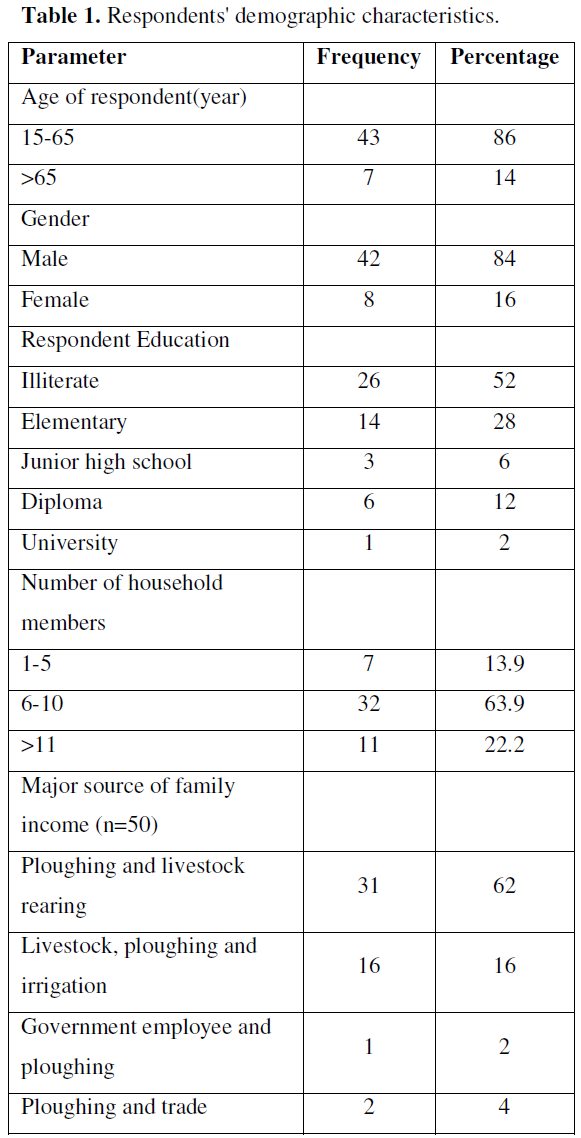
Household bee hive ownership and related aspects
As indicated in Table 2 from the total respondents the main purposes of keeping bees were found to be as a source of income and consumption. The survey result indicated that all of the respondents do have an experience of bee keeping, of which 74%, 20% and 6% of respondents have up to 10, 11-20 and more than 21 years of experience in beekeeping respectively (Table 2). As indicated in Table 2 from the total respondents 62 % of them do use traditional bee hive. From this study it was identified that a significant number of them (82%) produce honey for sale and diet followed by of use honey for diet, sale and medicine and diet only (Table 2).
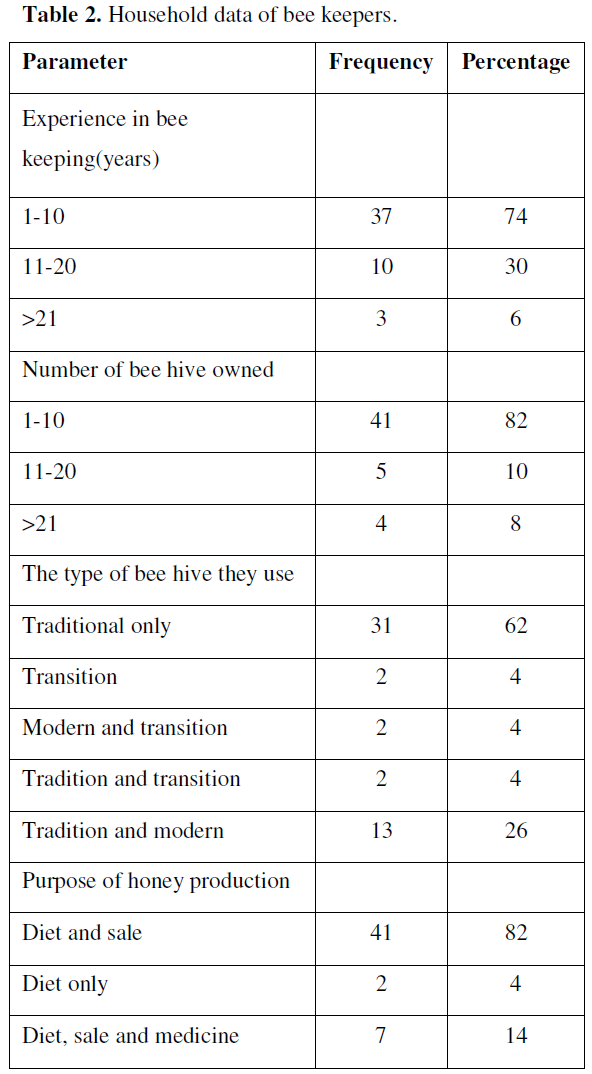
Assessment of pesticides and its effect on honey bees
As it is depicted in Table 3, 92 % of the respondents witnessed decrease in number of bee colonies among their previous bee colonies. In relation with it, the bee keepers were asked about the possible reasons for loss of honey bee colonies, as shown in Table 3, a significant proportion of interviewees (26.1%) indicated that the use of pesticides could be one of the reasons. In addition to this they mentioned pest, mismanagement and disease could also be the reasons (Table 3). Exclusively, 100 % of the interviewed beekeepers of the district indicated they are conscious of toxicity of pesticide negative effect on honey bees. Beekeepers were interviewed when observing decrement bee colonies. Hence from the total respondents 63% of them were observed after 5 year (Table 3).
Different degrees of Absconding (total loss of colony) were reported by the beekeepers, for instance only 8 % of them reported no colonies loss in the last two years, other reported a different degree colonies loss (Table 4). However, they do have different ideas how the bees get the toxicity as indicated in Table 4.
About 84 % of the respondents witnessed a decrement of the quality and production of the honey in the area; the same respondents were asked what the major causes honey quality decrements are, hence, chemicals poisoning, disease and processing and post-harvest problem were mentioned as the main problems that compromise quality and production of honey in the study area (Table 4).
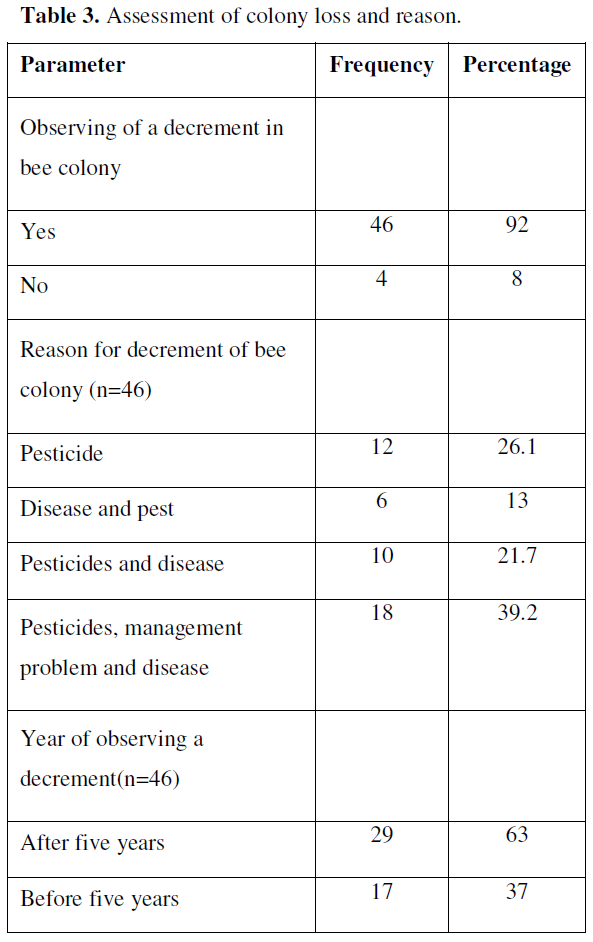
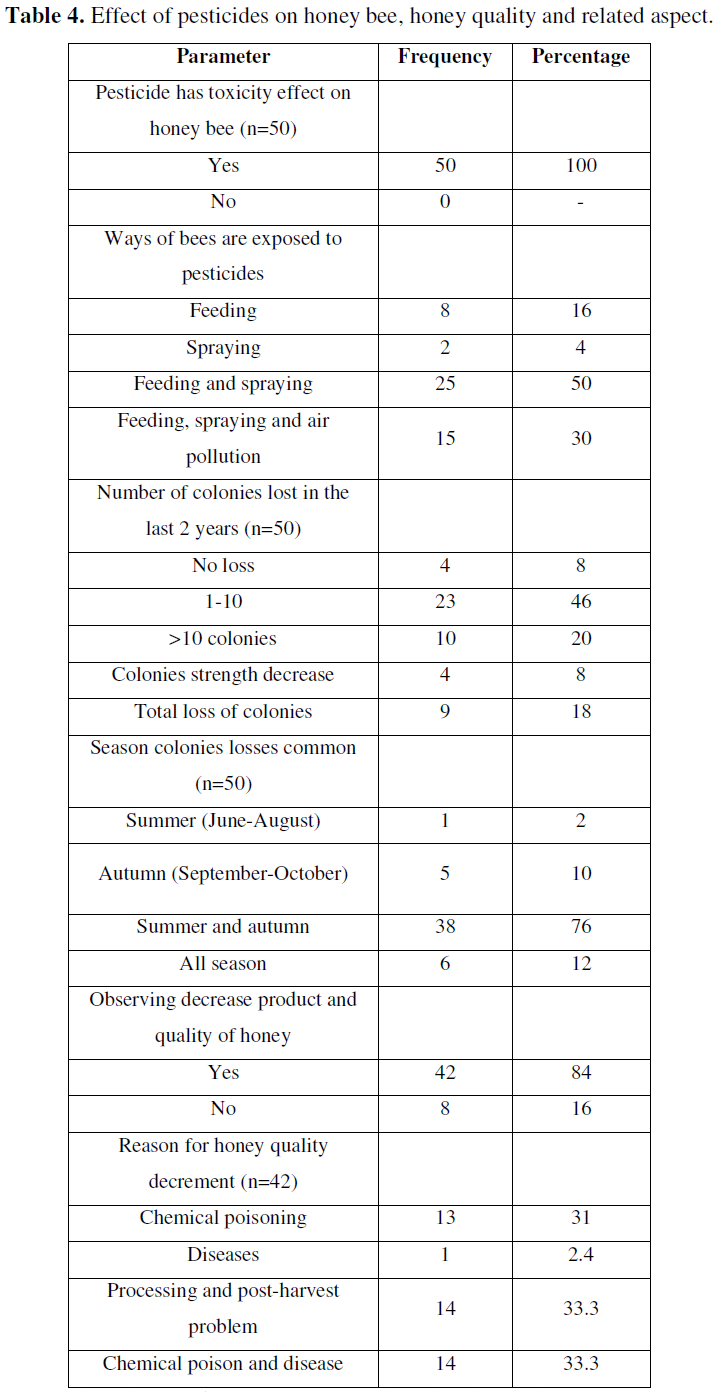
In this survey 76% of respondent do not know ways to protect bee from pesticides while, 14% and 10% protect their bee by feeding on sugar and moving to other place during pesticides application respectively (Figure 1).

Pesticides and their handling among bee keepers in Walmara district
Form the result Table 5 it is cleared that all the beekeepers of study area use pesticides for different purposes. The majority of the respondents reported that they use pesticides for the control of crop pest, weed and house pests and high pesticides use in summer and autumn. 74% of beekeepers were spray pesticides any time of the day and the rest, 14% and 12% every morning and afternoon respectively.

According to the respondents Figure 2 2, 4-D, Malathion, Diazinon, DDT and Ridomil are the major pesticides they have used frequently (Figure 2) and as indicated in Table 6, they use those pesticides beyond the recommended use of pesticides.
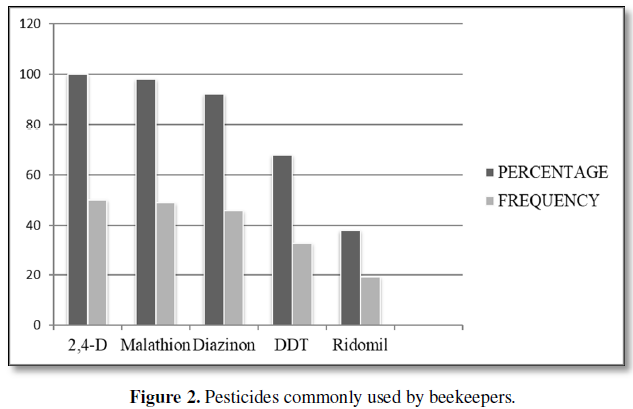

Laboratory Analysis of Toxicity Effect of Pesticides Mentioned by Beekeepers
Commonly used pesticides Malathion, Diazinon, 2, 4-D and Ridomil were tested for their toxicity effect (mortality test by feeding) on honeybees (Apismellifera) under laboratory condition and compared with honey solution in distilled water. The result indicated that Malathion and Diazinon have mortality 100% whereas 2, 4-D and Ridomil causes 44.2% and 41.32% mortality respectively and the control honey solution has 3% mortality within two hours (Figure 3).
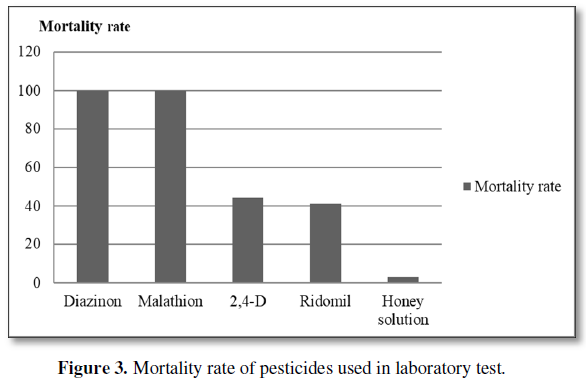
DISCUSSION
Questionnaires Survey Discussion
Household characteristics, bee hive ownership and related aspects
In this study the majority (84%) of beekeepers were found to be males. This finding is in line with the studies of Assemu [18], and Hartmann [19] in western Amhara region and southwest Ethiopia respectively, which indicate that beekeeping is dominated by men in Ethiopia. The limited number of female participations recorded in this finding might be due to the fact that even though parts or all of the beekeeping activities were performed by women reported as the work of men (head of the household).
This study also revealed that the 86% of beekeepers at age between 15-65 and 14% were at age greater than 65 years. This result showed that beekeeping is performed by active age groups and in most cases people at younger and older age is actively engaged in beekeeping activities. These findings are also inconsistent with Nuru [20] which states as beekeeping have advantages of being practiced by women, aged men and persons with disabilities.
From the total respondents 48% of the beekeeper were likely to attain elementary school or higher-level education, which is very helpful and advantageous for easily grasping of any type of trainings in general and apiculture trainings in particular and apply it into practice to increase honey and other hive products. On the contrary the majority of the respondents (52%) were illiterate, which requires a special attention by the district authorities.
In the present study predominantly (62%), traditional beehives were in the beekeepers’ houses. In this regard’s awareness creation should be exercised, because modern bee hives known to give more and quality honey when compared to traditional bee hives [21]. The main purposes of keeping honey bees were source of income and consumption (in 82 % of the cases). The result agrees with review of Gidey and Mekonnen [21], this result indicated that in Ethiopia honey is mainly produced for market.
Assessment of pesticides and their effect on honey bees
In this survey 92 % of the respondents witnessed decrease of the bee colonies among their previous bee colonies (Table 3), 46 % of the respondent reported a loss of 1-10 colonies of bees in the last two years ,this is an indication of financial loss due to absconding of honeybees from improved and traditional hives, for instance in one study done in district of AsgedeTsimbla, Tigray region come with a total of 429 traditional and 297 modern beehives were without honeybee colonies, representing an annual maximum loss of about USD 28,875 and 54,831, respectively [22]. In addition to this, the role of bees in crop pollination is even more important than their role as producers of honey and other products. In the absence of pollinators mainly honey bees, vegetable and seed crops and tree crops yield loss was estimated to be 26 and 43 percent, respectively [23]. The result of this study implies that the majority (76%) of the colony loss occurred in summer and autumn, this is associated with increased consumption of pesticides during this season to control pests and weeds and these seasons are considered period for honeybee to collect different nectar as a result easily exposed to pesticides.
The majority (63%) of the respondents stated that many of the colony losses happen in the last five years. This could be associated with the increasing use of pesticides by farmers for the control of plant pests and weeds (Table 3) and expansion of floricultures and modern agriculture in area bring the real possibility of damaging the delicate equilibrium in the colony, as well as contamination of hive products the result agree with review of Adeday [24], these authors indicated the use of chemicals and pesticides for crop pest, weeds, tsetse fly malaria and house pest control in Wukro district of Tigray region is a real threat to honey bee colonies and contamination of hive products. A similar problem has been reported by Kinati [25] in southwest Ethiopia.
This is further supported by the report of Pesticide Action network [26], which state that the weight of evidence demonstrates that pesticides are indeed key in explaining honey bee declines, both directly and in tandem with the other two leading factors, pathogens and poor nutrition.” As it is also watched by bee keepers involved in this study (Table 3).
Of the total beekeeping households interviewed, majority of them (84%) (Table 4) responded that they produce low product and poor-quality honey. This poor quality is probably attributed to many things, including the frequent use of pesticides by the farmers themselves (Table 4) and the horticulture industries in Walmara district. In some other studies done before it revealed that bees near agricultural fields are exposed to a variety of pesticides via multiple routes at harmful levels throughout the foraging period, which in turn compromise quality of honey due to the presence of pesticide residue in the honey [27-29] which requires a further investigation, because low productivity and poor quality of bee’s products are the major economic impediments for rural beekeepers [30].
A controversial finding in this study is that all the farmers do have a good knowledge about the toxicity effect of pesticides on honey bees and also describe the ways of exposure to pesticides (Table 4). But few beekeepers take measure to protect their honey bees from pesticides by moving in other place and feeding on sugar during pesticides application (Figure 1). This similar with Tessega [15] beekeepers in Burie district of Amhara region to control poisoning by chemicals, 17.1% use chemicals far from apiary, 13.8% use hand weeding, 6% close the hive entrance during application, 3.4% adjust time of chemical application and 57.4% do not use any control measures for chemical poisoning. So, a continuous and tangible awareness creation is required by the local agricultural extension’s office.
Most beekeepers in Walmara are illiterate and do not know the instruction of using pesticides and safe method use, as, a result they use different pesticides available at market mostly at any time of the day and they use it extensively throughout the year on recently expanded chat plantation in area and to control pest of different horticultural crop of irrigation. Similarly, as Abdulaziz state majority of farmers in Haromaya area use DDT and other unknown pesticides to grow their Khat and majority of them mixing DDT and other pesticides, especially malathion.
This practice of using DDT and other pesticides on Khat crop is causing different environmental problems such as extinction of some useful insects like honeybees and social as well as human health effects which need further investigation [31]. The type of chemicals used by the beekeepers sated (Figure 2) are known and proofed to be dangerous to honeybees [32,14]. In western countries insecticides and herbicides are marketed if the chemicals are less toxic and hazardous for honey bees. Such rules have to be applied in our country before we import chemicals indiscriminately.
Laboratory Analysis of Toxicity Effect of Pesticides Mentioned by Beekeepers
The acute toxicity (LD50) values of diazinon and malathion were about 100% per two hours. This due to honeybee has fewer protein encoding xenobiotic detoxifying enzymes [11]. Similarly, Smirle and Winston [33] showed that a significant linear relationship did exist between the acute toxicity of an organophosphorus insecticide, the diazinon and colony polysubstrate mono-oxygenase activity. Compared with diazinon and malathion the acute toxicity (LD50) values of ridomil (fungicides) and 2, 4-D (herbicides) were low, which were 41.32% and 44.2% respectively per two hours. As Alarcon and DeGrandistatefungicides have generally been assumed to be safe for bees but, some fungicides are demonstrably toxic to bee larvae and may also have synergistic effects when combined with other pesticides that they reduced the lifespan of adult bee [34] and similarly by vanEngelsdorp [35]. In line with this 2, 4-D also prepared to control the spread and growth of broadleaf weeds which compete with crops and threaten yields not to control insect but also have low toxicity and indirect effects [36]. Even though there is a degree of variation in the chemicals used for the toxicity (mortality test), the study clearly showed that the pesticides imported and used by the farmers for crop protection and pest control are highly toxic to honey bees. The impact of this chemicals for the country is huge because it causes reduction of colonies and honey quality, which in turn result in reduction of bee production and crop yield that obtained by honey bee pollination.
CONCLUSION AND RECOMMENDATIONS
Based on the evidence obtained in this study such as frequent use of pesticides and absence of acknowledgement of use of those chemicals by beekeepers, the presence of horticultural industry in area, the occurrence of decline honeybees colony number and strength, decrement of honey quality and production by laboratory test demonstrated that pesticides are indeed key in explaining honeybees declines, both directly and in tandem with the other two leading factors, pathogens and others in Walmara district.
Based on the above conclusion the following recommendations were forwarded
REFERENCES
No Files Found
Share Your Publication :